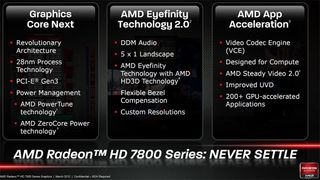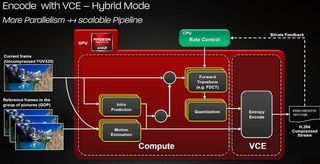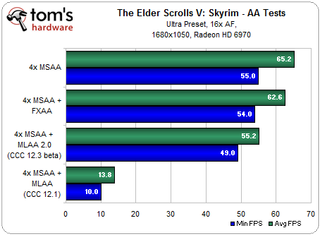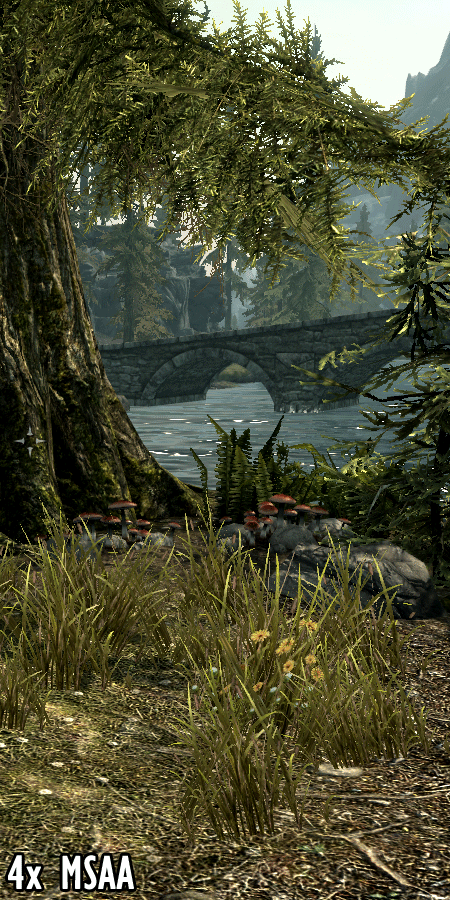AMD Radeon HD 7870 And 7850 Review: Pitcairn Gets Benchmarked
There's a big hole in between AMD's $450 Radeon HD 7950 and its $160 Radeon HD 7700. Today, the company introduces Radeon HD 7850 and 7870 to fill that gap, and they push a lot more performance than we expected. But are they really ready for prime time?
Features, MLAA 2.0, And SSAA Updates
The Radeon HD 7800 family includes the same list of features inherent to the other 7000-series cards. It centers on the Graphics Core Next architecture, it offers an evolved implementation of Eyefinity, it supports the same general-purpose GPU compute features as the other cards, it boasts ZeroCore Power management, and its tessellation performance is improved. Then, there are all of the capabilities that AMD claims, but that we can’t test: discrete digital multi-point audio (DDMA), Partially Resident Textures (PRTs), 3 GHz Fast HDMI support, and DirectX 11.1/OpenCL 1.2/DirectCompute 11.1 support. We covered all of that in our Radeon HD 7970 preview, so feel free to read that piece for more background.

We’re still missing one touted Radeon HD 7000 series feature, though: the video codec engine, or VCE. This is a multi-stream hardware-based H.264 encoder that potentially represents AMD’s answer to Intel’s Quick Sync technology. What we’ve been told, however, is that software for the feature currently exists, but because the drivers aren’t ready, it’s toggled off. At some point in the future when AMD is ready to go, it’ll switch VCE on and whatever application infrastructure is in place will work. Company representatives tell us to expect functionality in about a month.

Morphological Anti-Aliasing 2.0
This feature has nothing to do with the Radeon HD 7000 series specifically, as it’s an update to the morphological filtering algorithm used by all of AMD’s cards, from the Radeon HD 4000s onward. The company is claiming enhanced image quality and better performance with its improved MLAA 2.0 that’ll be included with the Catalyst 12.3 beta and Catalyst 12.4 WHQL drivers.
Since we have access to a preview version of 12.3, we ran a few tests to see how AMD’s updated software affects performance, if it can keep pace with Nvidia’s fast FXAA software-based anti-aliasing, and if image quality is better.
We used The Elder Scrolls V: Skyrim for our MLAA 2.0 tests because it’s a game that suffers from a lot of foliage aliasing artifacts that aren’t corrected by hardware-based multisample anti-aliasing. It’s also a good opportunity to compare MLAA 2.0 to FXAA, as the game includes native support for Nvidia’s technology.

It turns out that some games are buggy with MLAA and Skyrim seems to be one of them, making it a less than ideal platform for drawing comparisons between AMD’s first- and second-generation implementations. Fortunately, we can at least conclude that whatever issues were present previously are fixed. Overall performance falls short of Nvidia’s FXAA, but frame rates are only part of the story. Graphics quality is at least as important.
Stay on the Cutting Edge
Join the experts who read Tom's Hardware for the inside track on enthusiast PC tech news — and have for over 25 years. We'll send breaking news and in-depth reviews of CPUs, GPUs, AI, maker hardware and more straight to your inbox.

As you can see, FXAA yields a blurrier picture than AMD’s morphological anti-aliasing, and MLAA 2.0 results in an even crisper picture compared to the original. This might be something we revisit in a future story. For now, due to yet another tight deadline, we’re forced to move on.
Supersampling Anti-Aliasing Improvements
AMD claims that the Catalyst 12.2 driver adds supersampling support for DirectX 10 and 11 games, the lack of which we lamented in last year’s Anti-Aliasing Analysis, Part 1: Settings And Surprises article. Although supersampling is often unusable due to a large performance hit, it’s tied to AMD’s Adaptive Anti-aliasing, a largely ignored mode that has tremendous potential for improving image quality in games with aliased transparent textures without the huge performance penalty of SSAA. As we mentioned in that article, Nvidia’s implementation (called Transparent AA) enjoyed much better game compatibility with new titles. So we’re excited about the prospect of a reliable Adaptive AA mode, too.

AMD also says that automatic level-of-detail adjustments will be included with the Catalyst 12.3 and 12.4 WHQL drivers to improve the sharpness of textures while using SSAA. We’ve been told that this feature “is currently only available on Southern Islands-based cards." This isn’t something we were able to find proof of in the limited tests we had time to perform, but we plan to dig deeper into anti-aliasing in a follow-up article.
Current page: Features, MLAA 2.0, And SSAA Updates
Prev Page Radeon HD 7870 and 7850: A Paper Launch by Any Other Name Next Page Texture Optimizations And The Radeon HD 7000s-
hardcore_gamer Wow..7870 has nearly half the power-draw of GTX 570 and performs better . IMO this is the most impressive card in GCN line up so far.Reply -
esrever AMD saved the best for last it seems. Although a bit over priced, these cards are amazing performance/watt with all the new features. Nice to see the 7870 take a few blows at the 580 in a few games. Can't wait to see what kepler can do as well!Reply -
alex3064 alex3064what date is this 7850/7870 actually launchedi mean when will it be launched in marketReply -
theuniquegamer impressive performance of 7870 (i was disappointed by the 7770's performance )And what about microshuttering? Is it present in 7870 CF?Reply -
hardcore_gamer ilysamlWatch the benches well, the HD 7870 almost beating the GTX 580.Reply
Looking at the performance graphs, 7870 performs very close to 7950 which has 40% more SPs and a 384 bit memory interface. I think AMD reduced the performance of 79xx series on purpose so that they can release a better card just before the launch of Kepler. -
_Pez_ the 7870 is quite impressive. O.O almost the same gaming capability of the 580 for 350. OMG!Reply -
hardcore_gamer alex3064i mean when will it be launched in marketReply
It is there in the first page. "you won’t be able to buy the card until at least March 19th, AMD tells us." -
Onikage 7870 is a sensational card !!! even at this given price!!!Reply
what a card !!!
DAY 1 BUY !
Most Popular


